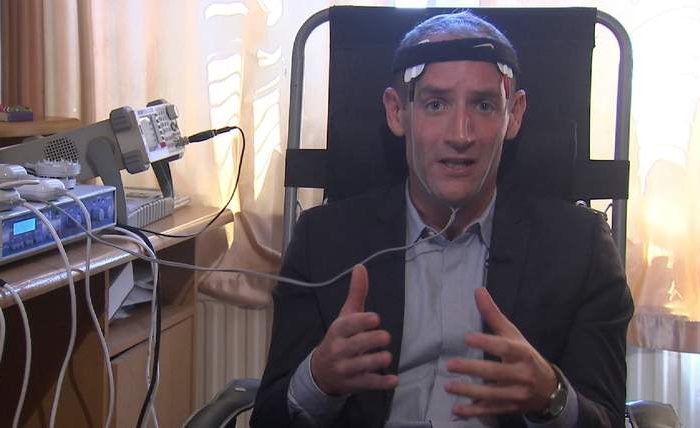


Tom Cheshire
Technology Correspondent
Andrew Vladimirov is jet lagged, so for 10 minutes in his northwest London flat, he holds lasers to his temples, to stimulate his brain.
The lasers pulse red and blue, powered by a Soviet-era machine on the table next to him.
Vladimirov is part of a growing subculture in the UK that uses homemade and off-the-shelf devices to modify their brains: to relax, to feel perkier, to treat anxiety, train their focus for sport, to learn languages, to swot for exams.
The most popular and well-established brain hacking technique is transcranial direct current stimulation (tDCS), which Vladimirov also uses. But he is continually looking for new methods: ultrasound, infrared, magnetic fields.
“I’ve got a variety of devices, some of which are DIY, some of which are sort of half-baked hacker devices, and some of which are industrial,” he says.
They are administered in different ways, including up the nose (the quickest way of accessing some parts of the brain).
“It can be used over different sensory areas to enhance the required sense – that’s how it can be used over, let’s say, speech centres, to enhance one’s speech,” he says.
“And obviously lots of research of this kind has been done in terms of rehabilitation medicine, in terms of recovery.”
There can be unanticipated consequences. When wearing a modified version of the “god helmet” – so called because some who wear it report feeling a “sensed presence” – Vladimirov felt the same effect.
“But that wasn’t pleasant. It was kind of a Grim Reaper,” he says.
“There could be risks which are not accounted for yet, like for instance a reasonably recent publication from (Oxford neuroscientist) Roi Cohen Kadosh which effectively says that if you promote one function you can inhibit another.
“It is a question of acceptable risk. When it comes to those effects some people will say: okay, I accept it.”
Vladimirov offers me a zap of a tDCS device made by a Russian friend of his: 2.5 milliamps straight to the cranium.
The feeling is a very localised pins and needles.
It does not seem to have much effect at first, but after 10 minutes I feel noticeably perkier and am much more talkative – according to Vladimirov, the anode is near my speech centre.
Camilla Nord, a neuroscientist at University College London, is examining whether tDCS might be effective in treating depression, and is using an MRI scanner to see how it affects the brain.
The mechanism behind different types of brain hacking is fairly well understood. Laser light causes neurons in a particular area of the brain to fire.
TDCS does not actually cause neurons to fire, but makes them more likely to: it increases “neuronal excitability”.
In effect, tDCS is a very specific and low-powered form of ECT – electroconvulsive therapy.
That is partly why Nord is interested because ECT, despite its barbaric image, remains an effective if extreme treatment for the worst forms of depression.
She is studying whether tDCS can make traditional cognitive behavioural therapy more effective.
The jury remains out on tDCS, though, according to Nord: “Like many manipulations you can do to the brain, of course it shows effects in a small subset of areas.
“But we’re not quite at the point where we can pinpoint what it does and doesn’t improve. My personal belief is that it does do something, but that we haven’t exactly figured out which circumstances it does it under.
“There are elements of it that make it a relatively safe technology, but playing with electricity at home is never the safest endeavour.”
Readymade tDCS devices are becoming more popular – the Foc.us and the sleeker Thync headset are both available now.
Nord thinks those devices are probably safer than DIY versions, but they are not subject to any regulations in the UK – for now. –SkyNews.com